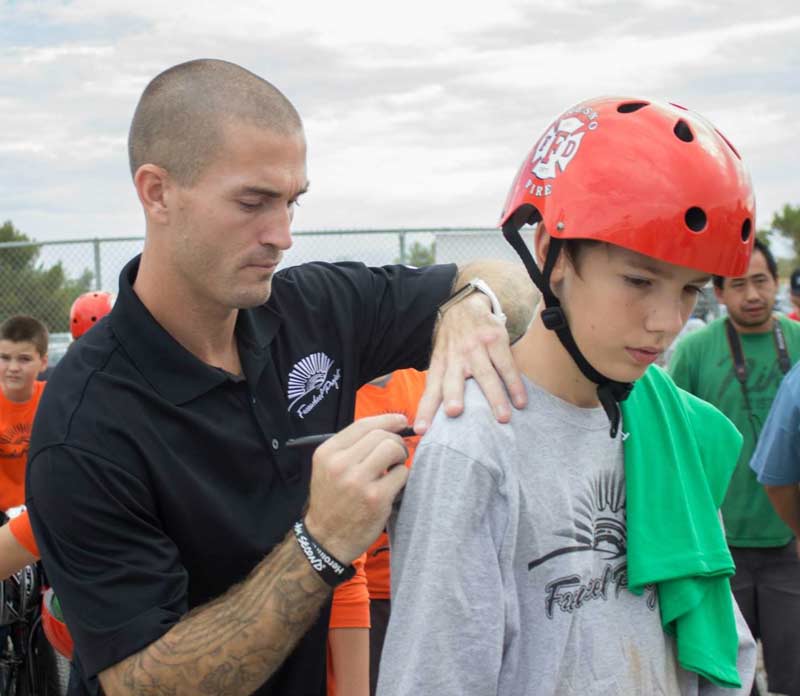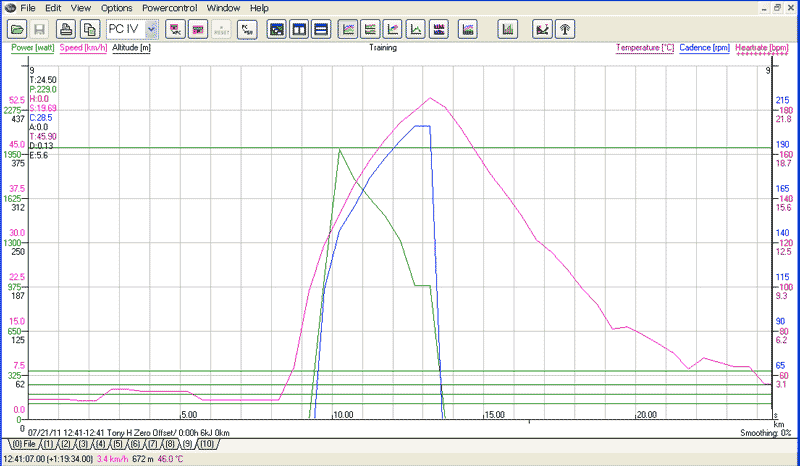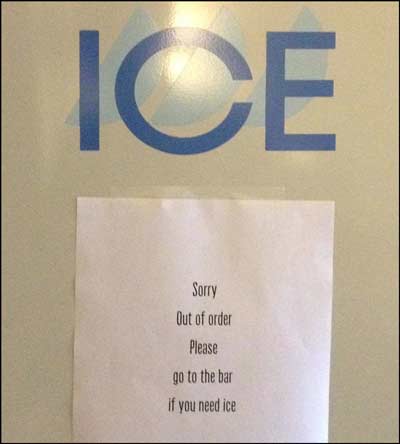
Coach Tony Hoffman signs autographs at a BMX clinic.
Tony Hoffman is a former AA Pro BMXer, who raced competitively as an amateur and AA Pro over the course of ten years. Starting BMX in the mid-1990’s, Hoffman has seen the sport of BMX evolve from the “party image sport” to the Olympic sport it has now become. During his time racing, Hoffman had a thirst for adopting technology into his training to help measure performance and understand what methods were working and if another approach could work better. After an ACL injury had sidelined Hoffman, ultimately leading him into his retirement, he continued to use technology for training, not on himself, but the athletes he now coaches.
Hoffman has spent his last five years of coaching working with several different training technologies and developing a unique correspondence coaching platform that reaches athletes across the globe. From young experts working up the ranks, to world champions, national champions and Olympic finalists. His adoption of technology and improvement in his current athletes has made him a high desired coach in the BMX community world wide.
Correspondence Coaching
Freelap USA — Tony, you do a lot of correspondence training because so many athletes need quality coaching. Obviously you do monitoring, blood analysis (InsideTracker), power meters, electronic timing, Velocity Based Training, but what do you do to keep the human element linking everything. Is a good phone call or Skype session showing up with compliance and connection when one is far away? Could you get into why remote coaching is such a great value and how coaches may be compensated by guiding year round?
Hoffman — I think that one of the strongest influences a coach can make with an athlete is when a relationship is built and there is absolute trust, for this to happen there has to be a certain level of communication. With remote coaching you can implement all of the safety nets in the world for your athletes with technology or have the best formula around but at the end of the day the athlete has to buy in completely with trust. I have a high volume of athletes, some traveling the world on Olympic and elite levels, others who are experts, that stay in the city or state which they live but one thing that does not change is my emphasis on the necessity for us to go beyond, “Coach” “Athlete”. I’m a big Google person and most of my communication with athletes is done via Google Hangouts and by doing this my athletes are able to see and feel my genuine care for their success as if I was there with them the whole time.
Remote coaching is extremely popular in BMX, and I think so because of its ease and implementation of structure to an athlete’s program. Not everyone can find a local coach they believe in or afford hands on coaching because that can raise the cost exponentially. I’m using Google Docs to create spreadsheets of schedules and data points for athletes to enter daily, making their whole program accessible via smartphone. With companies like PayPal and Google Wallet, receiving payments from athletes is a breeze, regardless of what country they live in. At any rate, the attraction is an athlete that can pay 1/4-1/2 the price for hands on coaching by choosing remote and still have a polished regiment.
Carl’s Take — Correspondence training is not always ideal, but not having something in place is a problem down the road for many coaches who have athletes that either live somewhere else during the offseason or they are competing and training in Europe during the competitive season (e.g. track and field). Having a few key pieces of equipment to help video or do monitoring is helpful, but the key is communicating effectively with good video conferencing. Several athletes like veterans and athletes who have no other options in their area are great users for remote or distance programs. Speaking of distance, endurance athletes are the best for correspondence programming but should have someone local because technique in any event is still important.
Benchmarks
Freelap USA — You have each athlete use electronic timing to manage power and transfer of the weight room and other areas of development. Can you share what tests you do to benchmark development over the season and career?
Hoffman — BMX and track and field sprinters share a lot of similarities concerning the physiological aspect, one of those being the ability to accelerate at phenomenal rates. An elite BMXer can get to 30mph in roughly 2.5 seconds at nearly 200 RPMs, creating over 2600 watts of power and after 30ft from the start they can change lanes in front of the competition. While we don’t see the high demand for maximal velocity sprints, since obstacles impede its entirety, the acceleration component is very critical. For all of my athletes, their 30ft sprint times are the biggest benchmark, whether uphill, downhill or flat. We use this along side 90ft sprint times, watts per kilogram of body weight on the bike, mean power on various lifts in the gym and velocity changes with given weights. I do monitor vertical jumping height, but I do not place an emphasis on it like I do some of my other benchmarks.
Carl’s Take — Every coach should have their benchmarks to hit based on their program. It’s nice to take tables and workouts from other coaches, but be careful because you are relying on second-hand data and specifics that may not carryover to your program. Benchmarks to me are a sign of coaches trying to improve athletes and not baby them with inappropriate monitoring programs and bogus metrics. Benchmarks are also calendar specific, such as testing in the fall not having the same weight as testing in the spring for speed and power athletes.
Making Sense of the Data
Freelap USA — RPMs and wattage are popular areas of power meters, but could you get into more detail on why you use the above methods when you have timing. Clearly velocity is important, and you can manage power and monitor fatigue, but what about training design?
Hoffman — A great mentor of mine said to me one time, “Technology should not be used as an absolute compass but an indicator over time of how we change and adapt our program.” Training design is essentially the heart of why I continue to implement power meters, HRV (see Smarter Heart Rate Monitoring), blood labs, and Velocity Based Training even though I can manage an athlete with timing only. What is the correlation between power, HRV, VBT and timing across different phases of an athletes training or competition phases? These are important questions we have to ask ourselves when looking at trends of performance and dissecting our formula because we can make small changes that have big impacts when done correctly. The hard part is leaving science to the scientist. As humans I find we love to over complicate simple processes. What I mean is, as coaches it’s not our job to find meaning to every piece of data we collect but we should be able to define what data we need and how that helps us design better programs that increase athletic performance. For example, by implementing VBT into my program I was able to find certain holes in my competition phase and by making a simple adjustment my athletes are doing much better in season for longer.
Carl’s Take — Velocity Based Training is growing with coaches in the weight room, but we need more effort in seeing what is done on the track or the field with speed and power. Combining both the weight room and speed data is far more effective when granularity and precision is high. The goal of technology is to help coaches get their program more polished rather than being reliant on the data to make all decisions.

Chart 1: Power meter graph showing exported data with wattage and time.
I have said this time after time the poor and lack of use of wattage in athlete performance metrics is a problem. Effort is hard to evaluate, but efficiency and raw output can easily collected by combining body metrics, blood testing, and output sensors. Coaches in different sports can start creating interesting profiling from beyond simple jump tests but get as deep as elastic efficiency ratings and even Hemoglobin Mass. The more you have have experience doing evaluations the more specific you can get without loosing the big picture.
Athlete Recovery
Freelap USA — Recovery of athletes is a big area, and many athletes don’t get enough sleep and eat properly. I think education is great, but what do you do in training to encourage a cause and effect relationship for the athlete to appreciate your advice?
Hoffman — Of all people, I am one to know that sometimes the best way to learn is by trial and error. I find it that most of my athletes go through this big learning curve of how technology exposes our shortcuts… We are not just talking rest and nutrition either, how about proper warm up? Did the athlete’s times start really high and get better through the workout? “How well did you warm up before you started because it looks like you spent half of your session getting warm?” Did you wake up with a low HRV and start a sprint session hot but quickly drop off? “Were you up all night snap chatting your girlfriend across the world and totally blow your breakfast?” With proper technology in place, an athlete is able to see how their daily choices affect their training/racing performance and as their coach we discuss the matters and how they can improve through different choices. It is then, after they see their mistakes clearly, they are able to begin the process of ticking boxes, previously skipped, that are important to their progress.
Carl’s Take — Many of my interviews have coaches talk about different recovery techniques or modalities, but always dance with the date that you came with, meaning don’t forget the basics in training and lifestyle. I have found that the combination of blood testing, physiological monitoring, training data, and the results themselves are enough for athletes to connect the dots.

Racing Schedules and Travel
Freelap USA — Racing schedules are international, and many athletes are not travel experts. How do you attack development long term but keep athletes fresh to race well without just doing maintenance workouts? Any creative solutions here?
Hoffman — This is a very good question and I won’t be providing any grand breaking information, haha. With BMX schedules, building an athletes engine and racing in season can be extremely tough. Here’s why, as an Elite, you can run up to 16 laps in a weekend, with laps anywhere between 400-500 meters in distance, the physical demand and need for recovery is high. Personally, I believe we run far too many laps because you finish one weekend totaling 16 laps, then catch a flight 2 days later for a race in Europe. Sponsors want you at all the races and money is on the line for a group of athletes who are not compensated fairly for their gifts, making the ability to skip a race for solid training hard. This means I have to be extra careful when and where we put workouts. One thing technology can not do for us, is give personal feed back on how they feel and sometimes I will take risk with my more intuitive athletes using personal feedback on their morale. I can talk to some of my Olympic and elite athletes about their levels of motivation and at times determine if we can deviate from the general protocol to try and meet a goal further down the line without it hurting us. Every sport and athlete is different and I think this is where we as coaches must get to know are athletes well enough that making these decisions goes beyond technology and protocol.
Carl’s Take — Travel and competition are always compromises to the need of balancing entertainment and preparation. Sometimes good solutions don’t exist beyond experience and knowing when it’s better to suggest a good Mexican restaurant on the road than worry too much if the ice machine is not working in some random city in Europe. I highly suggest athletes new to international travel get orientated with checklists and detailed itineraries so everything is planned. Many athletes are finding out the hard way with Olympic sport that a year on the road is why some post collegiate are struggling, not just because change of coaches or shoe contract pressures. Sometimes just having a coach there, or at least a friend on the circuit can be a big difference.
Please share so others may benefit from this article.
[mashshare]

